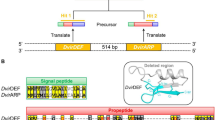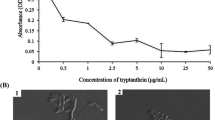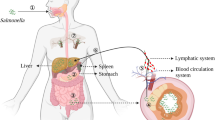Abstract
Studies pertaining to Salmonella enterica serovar Typhimurium infection by utilizing model systems failed to mimic the essential aspects of immunity induced by Salmonella enterica serovar Typhi, as the determinants of innate immunity are distinct. The present study investigated the physiological and innate immune responses of S. Typhi infected Caenorhabditis elegans and also explored the Ty21a mediated immune enhancement in C. elegans. Ty21a is a known live vaccine for typhoidal infection in human beings. Physiological responses of C. elegans infected with S. Typhi assessed by survival and behavioral assays revealed that S. Typhi caused host mortality by persistent infection. However, Ty21a exposure to C. elegans was not harmful. Ty21a pre-exposed C. elegans, exhibited significant resistance against S. Typhi infection. Elevated accumulation of S. Typhi inside the infected host was observed when compared to Ty21a exposures. Transcript analysis of candidate innate immune gene (clec-60, clec-87, lys-7, ilys-3, scl-2, cpr-2, F08G5.6, atf-7, age-1, bec-1 and daf-16) regulations in the host during S. Typhi infection have been assessed through qPCR analysis to understand the activation of immune signaling pathways during S. Typhi infections. Gene silencing approaches confirmed that clec-60 and clec-87 has a major role in the defense system of C. elegans during S. Typhi infection. In conclusion, the study revealed that preconditioning of host with Ty21a protects against subsequent S. Typhi infection.


Similar content being viewed by others
Abbreviations
- Ach:
-
Acetylcholine
- ASH:
-
Amphied sensilla neuron of head
- ATCC:
-
American Type Culture Collection
- CFU:
-
Colony forming unit
- CGC:
-
Caenorhabditis Genetic Centre
- DEPC:
-
Diethylpyrocarbonate
- IMTECH:
-
Institute of Microbial Technology
- LB:
-
Luria–Bertani
- LPS:
-
Lipopolysaccharide
- MAPK:
-
Mitogen activated protein kinase
- MTCC:
-
Microbial type culture collection
- NGM:
-
Nematode growth medium
- PAMP(s):
-
Pathogen associated molecular pattern(s)
- PMK:
-
p38 MAP kinase
- SCP/TAPS:
-
Sperm-coating protein/Tpx-1/Ag5/PR-1/Sc7
References
Germanier R, Fuer E (1975) Isolation and characterization of Gal E mutant Ty21a of Salmonella typhi: a candidate strain for a live, oral typhoid vaccine. J Infect Dis 131(5):553–558
Deng W, Liou SR, Plunkett G, Mayhew GF, Rose DJ, Burland V, Kodoyianni V, Schwartz DC, Blattner FR (2003) Comparative genomics of Salmonella enterica serovar typhi strains Ty2 and CT18. J Bacteriol 185:2330–2337
Boyle EC, Bishop JL, Grassl GA, Finlay BB (2007) Salmonella: from pathogenesis to therapeutics. J Bacteriol 189:1489–1495
Hotz C, Fensterle J, Goebel W, Meyer SR, Kirchgraber G, Heisig M, Fürer A, Dietrich G, Rapp UR, Gentschev I (2009) Improvement of the live vaccine strain Salmonella enterica serovar typhi Ty21a for antigen delivery via the hemolysin secretion system of Escherichia coli. Int J Med Microbiol 299:109–119
Kopecko DJ, Sieber H, Ures JA, Fürer A, Schlup J, Knof U, Collioud A, Xu D, Colburn K, Dietrich G (2009) Genetic stability of vaccine strain Salmonella typhi Ty21a over 25 years. Int J Med Microbiol 299:233–246
Aballay A, Ausubel FM (2001) Programmed cell death mediated by ced-3 and ced-4 protects Caenorhabditis elegans from Salmonella typhimurium-mediated killing. Proc Natl Acad Sci USA 98:2735–2739
Aballay A, Drenkard E, Hilbun LR, Ausubel FM (2003) Caenorhabditis elegans innate immune response triggered by Salmonella enterica requires intact LPS and is mediated by a MAPK signaling pathway. Curr Biol 13:47–52
Libby SJ, Brehm MA, Greiner DL, Shultz LD, McClelland M, Smith KD, Cookson BT, Karlinsey JE, Kinkel TL, Porwollik S, Canals R, Cummings LA, Fang FC (2008) Humanized nonobese diabetic-scid IL2rγnull mice are susceptible to lethal Salmonella Typhi infection. Proc Natl Acad Sci USA 107:15589–15594
Haghjoo E, Galan JE (2004) Salmonella typhi encodes a functional cytolethal distending toxin that is delivered into host cells by a bacterial-internalization pathway. Proc Natl Acad Sci USA 101:4614–4619
Pickard D, Wain J, Baker S, Line A, Chohan S, Fookes M, Barron A, Gaora PO, Chabalgoity JA, Thanky N, Scholes C, Thomson N, Quail M, Parkhill J, Dougan G (2003) Composition, acquisition, and distribution of the Vi exopolysaccharide-encoding Salmonella enterica pathogenicity island SPI-7. J Bacteriol 185:5055–5065
Curtiss R, Kelly SM (1987) Salmonella typhimurium deletion mutants lacking adenylate cyclase and cyclic AMP receptor protein are avirulent and immunogenic. Infect Immun 55:3035–3043
Hone DM, Attridge SR, Forrest B, Morona R, Daniels D, LaBrooy JT, Bartholomeusz RC, Shearman DJ, Hackett J (1988) A galE via (Vi antigen-negative) mutant of Salmonella typhi Ty2 retains virulence in humans. Infect Immun 56:1326–1333
Balamurugan k (2011) Bacterial infection alters proteome of Caenorhabditis elegans. J Protein Proteomic 2:49–53
Brenner S (1974) The genetics of Caenorhabditis elegans. Genetics 77:71–94
Sivamaruthi BS, Ganguli A, Kumar M, Bhaviya S, Pandian SK, Balamurugan K (2011) Caenorhabditis elegans as a model for studying Cronobacter sakazakii ATCC BAA-894 pathogenesis. J Basic Microbiol 51:540–549
Ausubel FM (2008) Current protocols in molecular biology. Wiley Interscience, New york, pp 26.0.1-26.0.2
Sivamaruthi BS, Balamurugan K (2012) Impact of food and folate supplementation during Salmonella typhi infection in Caenorhabditis elegans. J Protein Proteomic 3:9–14
McMullan R, Anderson A, Nurrish S (2012) Behavioral and immune responses to infection require Gaq-RhoA signaling in C. elegans. PLoS Pathog 8:e1002530
Troemel ER, Chu SW, Reinke V, Lee SS, Ausubel FM, Kim DH (2006) p38 MAPK regulates expression of immune response genes and contributes to longevity in C. elegans. PLoS Genet 2:e183
Mallo GV, Kurz CL, Couillault C, Pujol N, Granjeaud S, Kohara Y, Ewbank JJ (2002) Inducible antibacterial defense system in C. elegans. Curr Biol 12:1209–1214
O’Rourke D, Baban D, Demidova M, Mott R, Hodgkin J (2006) Genomic clusters, putative pathogen recognition molecules, and antimicrobial genes are induced by infection of C. elegans with M. nematophilum. Genome Res 16:1005–1016
Alper S, McBride SJ, Lackford B, Freedman JH, Schwartz DA (2007) Specificity and complexity of the Caenorhabditis elegans innate immune response. Mol Cell Biol 27:5544–5553
Wong D, Bazopoulou D, Pujol N, Tavernarakis N, Ewbank JJ (2007) Genome-wide investigation reveals pathogen-specific and shared signatures in the response of Caenorhabditis elegans to infection. Genome Biol 8:R194
Ewbank JJ (2006) Signaling in the immune response. In: WormBook (ed) The C. elegans research community. WormBook, doi: 10.1895/wormbook.1.83.1
Friedman DB, Johnson TE (1988) A mutation in the age-1 gene in Caenorhabditis elegans lengthens life and reduces hermaphrodite fertility. Genetics 118:75–86
Upadhyaya R (2010) The roles that age-1 and daf-2 genes play in aging. Eukaryon 6:93–95
Zhao YL, Wang DY (2012) Formation and regulation of adaptive response in nematode Caenorhabditis elegans. Oxid Med Cell Longev 2012:564093
Author information
Authors and Affiliations
Corresponding author
Electronic supplementary material
Below is the link to the electronic supplementary material.
12088_2013_424_MOESM1_ESM.tif
Fig. S1 Olfactory responses of C. elegans against S. Typhi and S. Typhi Ty21a. a NGM plate spotted with E. coli OP50 (Zone: A) and S. Typhi (Zone: B). b NGM plate spotted with E. coli OP50 (Zone: A) and S. Typhi Ty21a (Zone: B). c NGM plate spotted with S. Typhi (Zone: A) and S. Typhi Ty21a (Zone: B). The bacterial spots were indicated as a black circle. In all the combinations, worms were freely crawling over the bacterial spots which indicated that C. elegans does not exhibit the bacterial avoidance behavior against both S. Typhi and S. Typhi Ty21a. Supplementary material 1 (TIFF 592 kb)
12088_2013_424_MOESM2_ESM.tif
Fig. S2 Bacterial accumulations in C. elegans. The proliferation of Salmonella strains inside C. elegans was analyzed as described in “Materials and Methods” section. Bacterial load of S. Typhi and S. Typhi Ty21a over the course of infection. (TIFF 127 kb)
12088_2013_424_MOESM3_ESM.tif
Fig. S3 Diagrammatic representation of osmosensation assay. Salmonella enterica serovar Typhi infected or control worms were placed on NGM plate (a) and High osmolarity region of medium (b) was created around the worms. A Control animals recognized the high osmolarity zone and they have avoided the crossing of the high osmolarity area, whereas S. Typhi infected C. elegans B has lost their osmosensation and crossed the zone. (TIFF 443 kb)
12088_2013_424_MOESM4_ESM.tif
Fig. S4 Regulation of candidate immune genes. Expression patterns of clec-60, clec-87, age-1, bec-1, daf-16 during S. Typhi infection. Fold difference (2−ΔΔCt) of the expression of candidate genes were calculated after normalization with act-2 expression (housekeeping gene) and basal level expression of corresponding gene in control worms. The regulations of these genes indicated that infection also altered the aging related genes. (TIFF 337 kb)
12088_2013_424_MOESM5_ESM.tif
Fig. S5 Regulation of candidate immune genes. Expression patterns of lys-7, ilys-3, scl-2, cpr-2, F08G5.6, atf-7 during S. Typhi infection in naive host. Fold difference (2−ΔΔCt) of the expression of candidate genes were calculated after normalization with act-2 expression (housekeeping gene) and basal level expression of corresponding gene in control worms. (TIFF 387 kb)
12088_2013_424_MOESM6_ESM.tif
Fig. S6 Representative images of C. elegans depicting the phenotypic variation in clec-60 silenced C. elegans. Status of C. elegans after 36 h from the treatment with siRNA specific to clec-60 for 24 h and the tail swelling was highlighted by a circle (a, b) when compared to control (f) and the swelling phenotype of C. elegans after 72 h (c, d). The swelling at the posterior end is due to the vacuole formation (e, clearly indicated with arrows). The reason for the vacuole formation is not known. (TIFF 1969 kb)
12088_2013_424_MOESM7_ESM.tif
Fig. S7 Expression pattern of clec-60 and clec-87 in silenced and control C. elegans. Lane 1 shows the 100 bp ladder. No amplification was observed in clec-60 and clec-87 silenced worms for their respective gene. This results suggested that worms treated with RNAi were silenced for respective genes and also indicated the specificity of siRNA. (TIFF 184 kb)
12088_2013_424_MOESM8_ESM.tif
Fig. S8 Survival rate of clec-60 silenced C. elegans during S. Typhi infection. Rapid mortality was observed in S. Typhi infected clec-60 RNAi worms compared to the mortality of naïve worms exposed to S. Typhi. (TIFF 102 kb)
12088_2013_424_MOESM9_ESM.tif
Fig. S9 Survival rate of clec-87 silenced C. elegans during S. Typhi infection. Rapid mortality was observed in S. Typhi infected clec-87 RNAi worms compared to the mortality of naïve worms exposed to S. Typhi. (TIFF 103 kb)
Rights and permissions
About this article
Cite this article
Sivamaruthi, B.S., Balamurugan, K. Physiological and Immunological Regulations in Caenorhabditis elegans Infected with Salmonella enterica serovar Typhi. Indian J Microbiol 54, 52–58 (2014). https://doi.org/10.1007/s12088-013-0424-x
Received:
Accepted:
Published:
Issue Date:
DOI: https://doi.org/10.1007/s12088-013-0424-x




